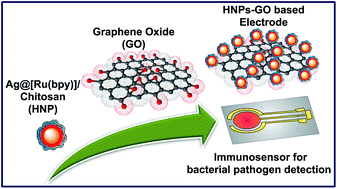Graphene oxide chemically decorated with Ag–Ru/chitosan nanoparticles: fabrication, electrode processing and immunosensing properties†
Abstract
Nanosheets of graphene oxide were chemically decorated with hybrid nanoparticles of a silver–ruthenium bipyridine complex (Ag@[Ru(bpy)3]2+) core and chitosan shell. The oxygenated groups of graphene oxide and the abundant amine groups in the chitosan layer on the surface of the hybrid nanoparticles allow functionalization reactions to occur. Changes in the optical, chemical and structural properties of graphene oxide occurred because the hybrid nanoparticles were studied using spectroscopy and microscopic techniques. Electrodes modified with hybrid nanoparticles-graphene oxide (HNPs-GO) displayed amplified steady-state anodic (IpA) and cathodic (IpC) peak currents with correlation coefficients of 0.9987 (IpA1), 0.9952 (IpA2) and 0.9964 (IpC1). Using the monoclonal antibody Listeria monocytogenes, a HNPs-GO immunosensor could specifically detect L. monocytogenes contaminated in buffer and milk, with a concentration range from 102 to 107 cells per mL and detection limit of 2 cells per mL. Our results suggest that selective optimization of the bio-recognition elements on the HNPs-GO electrode may find prospective use in food processing industries.


 Please wait while we load your content...
Please wait while we load your content...